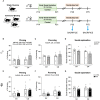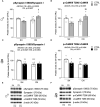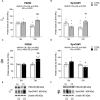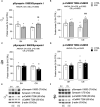Communal nesting shapes the sex-dependent glutamatergic response to early life stress in the rat prefrontal cortex
- PMID: 38835543
- PMCID: PMC11148342
- DOI: 10.3389/fpsyt.2024.1406687
Communal nesting shapes the sex-dependent glutamatergic response to early life stress in the rat prefrontal cortex
Abstract
Introduction: Early social environment, either positive or negative, shapes the adult brain. Communal nesting (CN), a naturalistic setting in which 2-3 females keep their pups in a single nest sharing care-giving behavior, provides high level of peer interaction for pups. Early social isolation (ESI) from dam and siblings represents, instead, an adverse condition providing no peer interaction.
Methods: We investigated whether CN (enrichment setting) might influence the response to ESI (impoverishment setting) in terms of social behavior and glutamate system in the medial prefrontal cortex (mPFC) of adult and adolescent male and female rats.
Results: Pinning (a rewarding component of social play behavior) was significantly more pronounced in males than in females exposed to the combination of CN and ESI. CN sensitized the glutamate synapse in the mPFC of ESI-exposed male, but not female, rats. Accordingly, we observed (i) a potentiation of the glutamatergic neurotransmission in the mPFC of both adolescent and adult males, as shown by the recruitment of NMDA receptor subunits together with increased expression/activation of PSD95, SynCAM 1, Synapsin I and αCaMKII; (ii) a de-recruiting of NMDA receptors from active synaptic zones of same-age females, together with reduced expression/activation of the above-mentioned proteins, which might reduce the glutamate transmission. Whether similar sex-dependent glutamate homeostasis modulation occurs in other brain areas remains to be elucidated.
Discussion: CN and ESI interact to shape social behavior and mPFC glutamate synapse homeostasis in an age- and sex-dependent fashion, suggesting that early-life social environment may play a crucial role in regulating the risk to develop psychopathology.
Keywords: NMDA receptors; communal nesting; early-life stress; prefrontal cortex; sex difference; social isolation.
Copyright © 2024 Mottarlini, Rizzi, Targa, Buzzelli, Di Trapano, Rullo, Candeletti, Ciccocioppo, Fattore, Romualdi, Fumagalli, Trezza and Caffino.
Conflict of interest statement
The authors declare that the research was conducted in the absence of any commercial or financial relationships that could be construed as a potential conflict of interest.
Figures







Similar articles
-
Sexual Harassment and Prevention Training.2024 Mar 29. In: StatPearls [Internet]. Treasure Island (FL): StatPearls Publishing; 2025 Jan–. 2024 Mar 29. In: StatPearls [Internet]. Treasure Island (FL): StatPearls Publishing; 2025 Jan–. PMID: 36508513 Free Books & Documents.
-
Peripuberty Is a Sensitive Period for Prefrontal Parvalbumin Interneuron Activity to Impact Adult Cognitive Flexibility.Dev Neurosci. 2025;47(2):127-138. doi: 10.1159/000539584. Epub 2024 Jun 3. Dev Neurosci. 2025. PMID: 38830346 Free PMC article.
-
Short-Term Memory Impairment.2024 Jun 8. In: StatPearls [Internet]. Treasure Island (FL): StatPearls Publishing; 2025 Jan–. 2024 Jun 8. In: StatPearls [Internet]. Treasure Island (FL): StatPearls Publishing; 2025 Jan–. PMID: 31424720 Free Books & Documents.
-
Personally tailored activities for improving psychosocial outcomes for people with dementia in long-term care.Cochrane Database Syst Rev. 2018 Feb 13;2(2):CD009812. doi: 10.1002/14651858.CD009812.pub2. Cochrane Database Syst Rev. 2018. Update in: Cochrane Database Syst Rev. 2023 Mar 13;3:CD009812. doi: 10.1002/14651858.CD009812.pub3. PMID: 29438597 Free PMC article. Updated.
-
Ketamine and other glutamate receptor modulators for depression in bipolar disorder in adults.Cochrane Database Syst Rev. 2015 Sep 29;(9):CD011611. doi: 10.1002/14651858.CD011611.pub2. Cochrane Database Syst Rev. 2015. Update in: Cochrane Database Syst Rev. 2021 Oct 8;10:CD011611. doi: 10.1002/14651858.CD011611.pub3. PMID: 26415966 Updated.
Cited by
-
Early Life Social Isolation Dysregulates Social Reward Processing, BDNF Signaling, and Intracellular Vesicular Sorting in the Nucleus Accumbens of Male and Female Rats.J Neurochem. 2025 Aug;169(8):e70181. doi: 10.1111/jnc.70181. J Neurochem. 2025. PMID: 40762328 Free PMC article.
-
AMP-Activated Protein Kinase Treatment Ameliorates Chronic Restraint Stress Induced Memory Impairment in Early Adolescent Rat by Restoring Metabolite Profile and Synaptic Proteins.Neurochem Res. 2024 Nov 18;50(1):19. doi: 10.1007/s11064-024-04285-8. Neurochem Res. 2024. PMID: 39556261
-
Long lasting effects of perinatal exposure to the Chlorpyrifos pesticide on sleep, breathing, and neuroinflammation in adult mice.PLoS One. 2025 Aug 1;20(8):e0328581. doi: 10.1371/journal.pone.0328581. eCollection 2025. PLoS One. 2025. PMID: 40748870 Free PMC article.
References
Grants and funding
LinkOut - more resources
Full Text Sources
Miscellaneous

